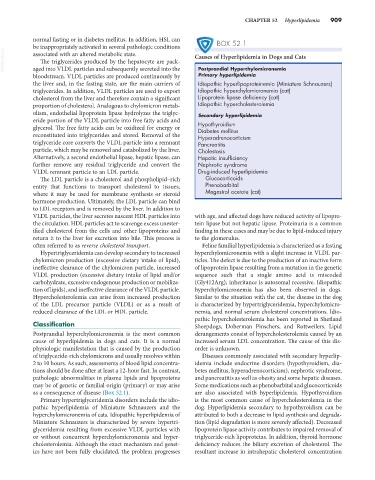Page 937 - Small Animal Internal Medicine, 6th Edition
P. 937
CHAPTER 52 Hyperlipidemia 909
normal fasting or in diabetes mellitus. In addition, HSL can
be inappropriately activated in several pathologic conditions BOX 52.1
VetBooks.ir associated with an altered metabolic state. Causes of Hyperlipidemia in Dogs and Cats
The triglycerides produced by the hepatocyte are pack-
aged into VLDL particles and subsequently secreted into the
Primary hyperlipidemia
bloodstream. VLDL particles are produced continuously by Postprandial Hyperchylomicronemia
the liver and, in the fasting state, are the main carriers of Idiopathic hyperlipoproteinemia (Miniature Schnauzers)
triglycerides. In addition, VLDL particles are used to export Idiopathic hyperchylomicronemia (cat)
cholesterol from the liver and therefore contain a significant Lipoprotein lipase deficiency (cat)
proportion of cholesterol. Analogous to chylomicron metab- Idiopathic hypercholesterolemia
olism, endothelial lipoprotein lipase hydrolyzes the triglyc- Secondary hyperlipidemia
eride portion of the VLDL particle into free fatty acids and Hypothyroidism
glycerol. The free fatty acids can be oxidized for energy or Diabetes mellitus
reconstituted into triglycerides and stored. Removal of the Hyperadrenocorticism
triglyceride core converts the VLDL particle into a remnant Pancreatitis
particle, which may be removed and catabolized by the liver. Cholestasis
Alternatively, a second endothelial lipase, hepatic lipase, can Hepatic insufficiency
further remove any residual triglyceride and convert the Nephrotic syndrome
VLDL remnant particle to an LDL particle. Drug-induced hyperlipidemia
The LDL particle is a cholesterol and phospholipid–rich Glucocorticoids
entity that functions to transport cholesterol to tissues, Phenobarbital
where it may be used for membrane synthesis or steroid Megestrol acetate (cat)
hormone production. Ultimately, the LDL particle can bind
to LDL receptors and is removed by the liver. In addition to
VLDL particles, the liver secretes nascent HDL particles into with age, and affected dogs have reduced activity of lipopro-
the circulation. HDL particles act to scavenge excess unester- tein lipase but not hepatic lipase. Proteinuria is a common
ified cholesterol from the cells and other lipoproteins and finding in these cases and may be due to lipid-induced injury
return it to the liver for excretion into bile. This process is to the glomerulus.
often referred to as reverse cholesterol transport. Feline familial hyperlipidemia is characterized as a fasting
Hypertriglyceridemia can develop secondary to increased hyperchylomicronemia with a slight increase in VLDL par-
chylomicron production (excessive dietary intake of lipid), ticles. The defect is due to the production of an inactive form
ineffective clearance of the chylomicron particle, increased of lipoprotein lipase resulting from a mutation in the genetic
VLDL production (excessive dietary intake of lipid and/or sequence such that a single amino acid is miscoded
carbohydrate, excessive endogenous production or mobiliza- (Gly412Arg); inheritance is autosomal recessive. Idiopathic
tion of lipids), and ineffective clearance of the VLDL particle. hyperchylomicronemia has also been observed in dogs.
Hypercholesterolemia can arise from increased production Similar to the situation with the cat, the disease in the dog
of the LDL precursor particle (VLDL) or as a result of is characterized by hypertriglyceridemia, hyperchylomicro-
reduced clearance of the LDL or HDL particle. nemia, and normal serum cholesterol concentrations. Idio-
pathic hypercholesterolemia has been reported in Shetland
Classification Sheepdogs, Doberman Pinschers, and Rottweilers. Lipid
Postprandial hyperchylomicronemia is the most common derangements consist of hypercholesterolemia caused by an
cause of hyperlipidemia in dogs and cats. It is a normal increased serum LDL concentration. The cause of this dis-
physiologic manifestation that is caused by the production order is unknown.
of triglyceride-rich chylomicrons and usually resolves within Diseases commonly associated with secondary hyperlip-
2 to 10 hours. As such, assessments of blood lipid concentra- idemia include endocrine disorders (hypothyroidism, dia-
tions should be done after at least a 12-hour fast. In contrast, betes mellitus, hyperadrenocorticism), nephrotic syndrome,
pathologic abnormalities in plasma lipids and lipoproteins and pancreatitis as well as obesity and some hepatic diseases.
may be of genetic or familial origin (primary) or may arise Some medications such as phenobarbital and glucocorticoids
as a consequence of disease (Box 52.1). are also associated with hyperlipidemia. Hypothyroidism
Primary hypertriglyceridemia disorders include the idio- is the most common cause of hypercholesterolemia in the
pathic hyperlipidemia of Miniature Schnauzers and the dog. Hyperlipidemia secondary to hypothyroidism can be
hyperchylomicronemia of cats. Idiopathic hyperlipidemia of attributed to both a decrease in lipid synthesis and degrada-
Miniature Schnauzers is characterized by severe hypertri- tion (lipid degradation is more severely affected). Decreased
glyceridemia resulting from excessive VLDL particles with lipoprotein lipase activity contributes to impaired removal of
or without concurrent hyperchylomicronemia and hyper- triglyceride-rich lipoproteins. In addition, thyroid hormone
cholesterolemia. Although the exact mechanism and genet- deficiency reduces the biliary excretion of cholesterol. The
ics have not been fully elucidated, the problem progresses resultant increase in intrahepatic cholesterol concentration

